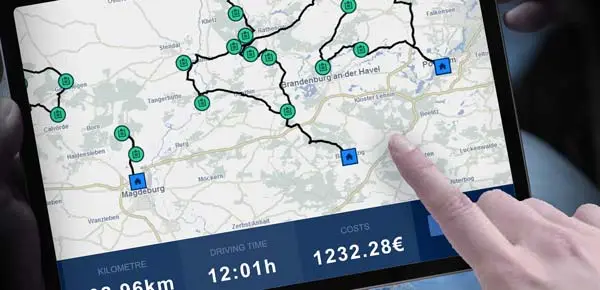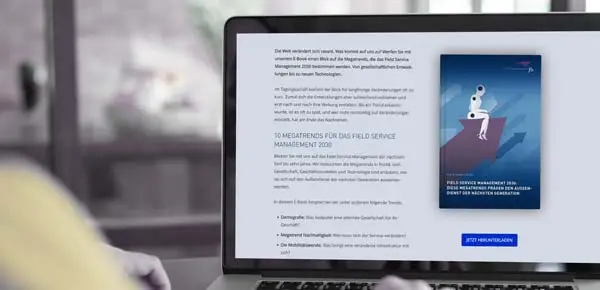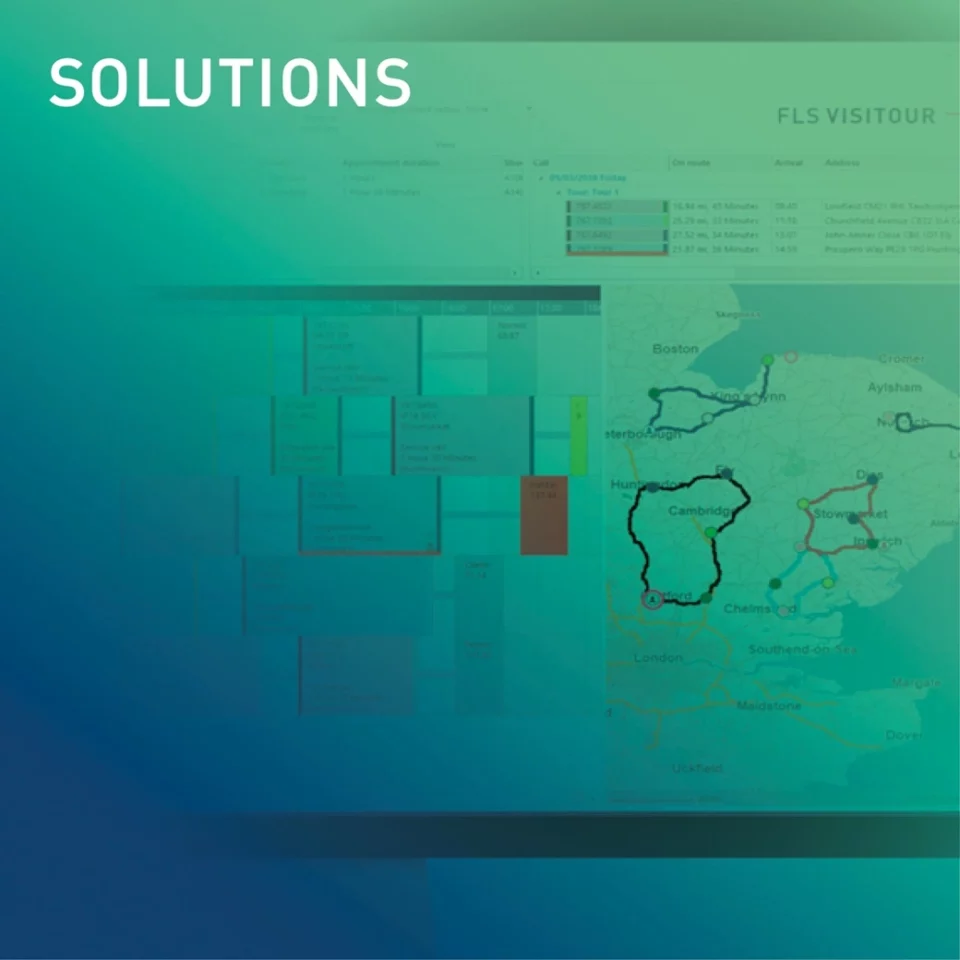
BLOG / SOLUTIONS · ROUTE PLANNING SOFTWARE
ONE SOLUTION TO REDUCE COST IN THE VEHICLE BREAKDOWN AND RECOVERY INDUSTRY
19 October 2022 · James Alex Waldron
It doesn't have to be this way.
FLS VISITOUR is a dynamic field dispatch and route optimisation solution that is flexible to your unique needs, including the live optimisation of single call outs within an 'already planned' day of scheduled appointments (such as windscreen replacement and accident repair).
The key difference is the algorithm-based real-time, time-of-day driving speeds along with countless 'cost'-based parameters. This providers dispatchers with an unmatched transparency—why an optimisation decision, such as a route plan, was calculated. You create your own parameters as your business grows - such as:
- Do you want to operate in the most possible cost-efficient way
- Do you want to balance work orders across all of your field employees and eliminate overtime
- Do you want to arrive to the customer at the earliest possible time
FIX 1
SECURE THE LOCATION WITH GEOCODING
Mirroring the pain points of the unexpected call out is the unknown location. Your customer may be able to give you a road name or a local point of interest. In some cases, (such as a booked tyre recycling or consumables replacement) you may know the route to a regular customer's premises. However, travel speed, real-life distance, or arrival time cannot be determined by a dispatcher who lacks location intelligence. The foundation for optimising the entire routing and dispatch process must be geocodes and associated elements.The unique PowerOpt algorithm increases critical accuracy by producing route results with additional identifiers such as house numbers, side of the street, intersections, and one-way streets. Outcomes are immediately influenced by further data, such as traffic jams and active roadworks. Dispatchers set their field-based technicians/operatives and their vehicles onto an overlapping radius that replaces hard borders. For mobile workforces, the outdated 'service patch' is eliminated and this results in an even greater number of available resources. Geocodes reduce travel time, distance, and carbon emissions, and FLS VISITOUR determines the fastest possible route, never the shortest.
FIX 2
DISPATCH THE CORRECT VEHICLE TYPE
Responding to a call out should begin with data - principally, matching the call out type with available resources before agreeing the visit. If your organisation is still agreeing to visit a customer, then finding resource, you're likely to create cost and make mistakes. Van, flatbed, tow truck, number of passengers to rescue? Availability data is linked in to your cost-based service radius, and dynamic route plannning accounts for limitations such as vehicle restrictions (height, size, and weight).Running a 24-hour operation means there is never a 'good' time for one of your own fleet vehicles to be off-the-road for its own maintenance. The best results are achieved through automated reallocation of resources using a solution to make calculations in the background. You will save time and money by pairing ready-to-go vehicles with a technician in possession of the necessary qualifications, such as a tow truck training. Call outs are as efficient as possible, and roadside customers are kept updated with live data.
FIX 3
OPERATIVE SKILLS AND CERTIFICATIONS
Dispatching your field employees to numerous call outs and types over a 24-hour operation (especially in the roadside assistance market) presents obvious elements of risk. Route planning questions arise, such as whether two technicians/operatives are better than one, and if the response requires (for example) fire/fuel handling safety training—plus their own capabilities such as coping with crawl spaces or heights.Dynamic route planning dispatches against your organisation's risk assessment and risk reduction parameters. Further, digitised call outs estimate task completion time, and integrated real-time telematics data with progress tracking removes many of the 'unknowns' from lone workers. Repeat call outs to a similar location are fed into the automated decision making to guide arrangements, and clear safety details may be tagged in to the call out's instruction.
FOCUS: FIELD SERVICE AND THE AUTO INDUSTRY
Route planning software works to control and optimise field service operations. Real-time route planning systems help technical service teams, surveyors, and experts to optimally plan and coordinate call outs with resources.Discover more solutions in the Auto industry:
ROUTE PLANNING TO REDUCE FUEL USE AND DRIVING TIME
The average difference in fuel cost for a Ford Transit van to drive 40K miles in a year? — a minimum of £2000 extra versus 2021. Dynamic route planning optimises for the shortest route to meet the call out SLA, and in turn means driving less and using less fuel. Will repeat visits be necessary? Such as a follow-up visit by an inspector, and when? How is this planned in to routing? By moving away from manual dispatching, one FLS VISITOUR customer now travels over 3,000 miles less every day and uses around 45% less fuel (saving the organisation an average of £11,000 daily). This proves it is possible to increase efficiency and balance workloads with the same number of mobile technicians and to grow profitability.FIX 5
TRACK COSTS AND SHORTEN PAYMENT WINDOWS
Technology evolves and self-learning algorithms grow more powerful throughout enterprise resource planning. As a result, you may maximise the utilisation of available resources and further optimise strategic planning. With all data considered and pushed to employee devices at the roadside, they can access crucial information regarding the object/asset, agreed service level, and contact history with the same transparency as the dispatch desk. This enhances the opportunity for a first-time-fix and assists with accurate records of spent materials.Organisations can realise added value in the resulting data for the Accounts department, almost immediately. The benefits of integrating dynamic route planning tools with your ERP go beyond budgeting for the next financial year. Capacity, completed works, and customer data is available to track and manage the progress of client contracts (especially relevant for outsourcing practices and chargebacks). Knowledge gaps between process owners & dispatchers frequently develop in organisations. Consciously and unconsciously acquired information forms the basis of experience, which is lost if a service contract manager quits or is away from work for an extended period of time. Duplicate data maintenance is eliminated with interfaces between your ERP/CRM system. KPI dashboards are available to all parties.
FIX 6
AUTOMATED DATA FOR REGULATORY REPORTING
Offering the benefits of a service package comes with responsibility. Regulatory limitations affect:- How call outs into the field are dispatched (employee working hours/training)
- Reporting results for safety and insurance purposes (recalls)
- Tracing recyclable materials (such as tyres in the 'circluar economy')
FIELD SERVICE SOLUTIONS FOR THE VEHICLE BREAKDOWN AND RECOVERY INDUSTRY
To gain an understanding of tools to optimise the field experience for your workforce and client contracts book a short discussion or contact us at info@fastleansmart.com.Read more:
Professional Route Planning Software: Are you ready?
Route planning SaaS: Your competitive advantage
Automated Route Planning: the power of algorithms for field service

JAMES ALEX WALDRON
UK Marketing Manager
+44(0) 1183 800189
Send email
James Alex Waldron has worked in written communications for over 15 years. Since 2021, he has written for FLS and the Solvares Group on the topics of digital field service transformation and mobile workforce management, and regularly provides insight to the industry press.




